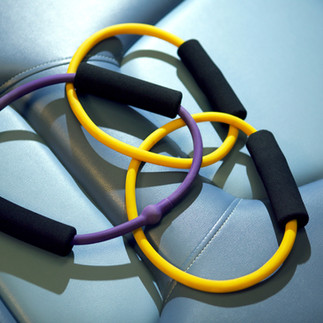Elastic Band Stretching: Build Fascia Strength & Lasting Flexibility
- Victoria R. Hackworth

- Jun 8
- 3 min read
The Forgotten Power of the Elastic Band
Once upon a time, stretching and exercise were one and the same. They shared a name, a purpose, and a philosophy: move the body to strengthen it.
Somewhere along the way, they split.
Exercise became about building—muscles that push, pull, and endure.
Stretching became about recovering—the quiet after the storm.
But here’s the truth:
Stretching strengthens, too. It just strengthens differently.
A Different Kind of Strength
Exercise strengthens a muscle along its length—bigger, tighter, more powerful.
Stretching, when done with intention, strengthens the body across its width—building flexibility, integrity, and adaptability. It doesn’t puff up the tissue—it makes it wise. Durable. Spacious.
That’s why I teach the Elastic Band Concept.
Because real strength isn’t just about doing more.
Sometimes it’s about doing just enough—on purpose.
Part 1: Understanding the Concept
In our sessions, we often explore fascia—the connective tissue that wraps around everything inside you. When fascia becomes dry, tight, or stuck, it limits movement and dulls sensation.
But fascia is like an elastic band—with gentle, steady tension, it reawakens. It learns to loosen, glide, and adapt again.
The Elastic Band Concept is simple:
Stretch the fascia, not force the muscle. Pull gently. Breathe. Wait. Let your body reconnect.
How to Do It
This kind of stretching isn’t about pushing—it’s about listening and guiding. Each small action creates a ripple through your whole system.
Ease into position with just enough tension to feel connected—not strained. A little resistance goes a long way. You are not trying to stretch to your limit—you’re helping your fascia re-learn how to move with ease.
Pull from above: Wrists → initiate from shoulders. Ankles → initiate from hips. This distributes effort, protects joints, and engages the fascia in its full length.
Focus on posture. Even if you're stretching one area, how you sit, stand, or lie matters. Comfortable, well-aligned posture allows energy and nerve signals to travel more freely—not just through the stretch, but throughout the whole body. You're creating full-body conduction with every hold.
Breathe slowly and steadily. Deep, rhythmic breathing tells your nervous system: you’re safe. It softens unnecessary tension, increases oxygen flow, and allows the fascia to relax and receive. When your breath stays slow, your body retains the stretch in a less reactive, less stressful state.
Notice shakiness. It’s not a failure—it’s your system waking up, re-patterning how to hold and move. Over time, that shakiness will stabilize.
Stop at fatigue. Not collapse—but when you reach the edge of comfort. That’s your body’s natural stop sign.
Release gently. Let go with care, not force. The nervous system remembers the way you exit as much as how you begin.
When & How Often
Week 1: Once a day
Week 2: Add a second session a day.
The following weeks, make and find a consistent flow that works best for you.
The key is not how hard you do it—but how often you return after adequate rest.
Why It Matters
This kind of stretching isn’t for show. It’s for life.
It’s for when you want to feel stronger without gripping. More open without collapse. More present without pain.
This is fascia-focused strength. Quiet. Intentional. Lasting.
Your body is listening. And it's ready.
The insights shared here are based on my personal experience and learning. They’re meant to support your wellness—not replace medical advice.
If you're considering changes to your hydration, diet, or routine, please consult with your doctor to ensure they’re right for you.
Your health matters deeply, and informed choices are always encouraged.







Comments